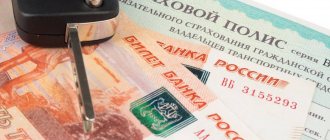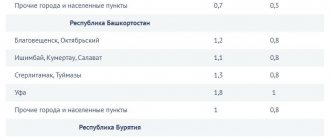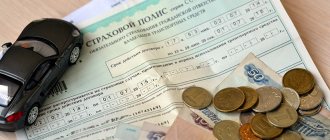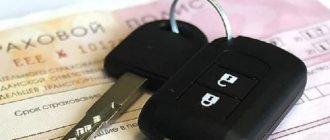If you want to find out how to solve your particular problem, please use the online consultant form or call +7 (Moscow) +7 (St. Petersburg)
It's fast and free!
Before contacting an insurance company, a potential client can independently determine the cost of the policy. For this purpose, a special formula for calculating compulsory motor liability insurance is used.
In addition, on the official websites of insurers and RSA you can find online calculators that allow you to quickly calculate the required amount, taking into account all factors.
How is compulsory motor liability insurance calculated using the formula?
The calculations are based on the basic insurance rate, which is multiplied by various variables that affect the final cost of the policy.
Such factors include the driving experience of the potential policyholder, his age, type, class and make of the car, its date of manufacture, degree of wear of parts, engine power, territory of use, etc.
Of no small importance is the purpose of using the car and the number of people allowed to drive it. Thus, vehicles used in commercial activities (for example, for cargo transportation, taxis) are insured at an increased rate, so insurance for such a vehicle will cost several times more than a standard policy.
Below is the formula for calculating compulsory motor liability insurance in 2021. With its help, it is possible to determine the amount of insurance premium for a specific car, taking into account various variables.
TB * KO * KS * CT * KM * KVS * KN * KBM = T
In this algorithm, the listed components have the following meanings:
- T – final price of the insurance premium;
- TB – the size of the basic tariff;
- KO – the value of the limiting coefficient, the indicators of which depend on the number of drivers who have access to the car;
- KS – seasonality coefficient, that is, the period of use of transport;
- CT – the value of the territorial coefficient (we are talking about taking into account the region in which the owner of the vehicle is registered);
- KM - coefficient responsible for the power of the car engine (accounting is carried out in horsepower);
- КН – coefficient, the value of which depends on the presence or absence of any traffic violations in the driver’s past;
- KVS is a coefficient that takes into account the age of the driver of the insured vehicle and his driving experience;
- KBM is the “bonus-malus” coefficient, reflecting the presence of insured events that occurred in the past due to the fault of the person indicated in the insurance.
Insurance companies undertake to use this formula for compulsory motor liability insurance in 2021, therefore they do not have the right to unreasonably inflate the price of the policy.
How is the insurance premium calculated?
As mentioned above, basic tariffs and coefficients are regulated by law. This means that a compulsory motor liability insurance policy should cost the same in any insurance company.
You must understand that the cost of insurance cannot be 1000 rubles. The basic cost of the policy is 3,432 rubles, and the calculation is made taking into account the coefficients. For example, a 21-year-old driver from Moscow will have to pay the insurance company more than 6 thousand rubles for an annual MTPL policy.
The size of the insurance premium (the cost of each specific policy) is formed by simple arithmetic: the basic insurance rate is multiplied by insurance coefficients, which can significantly increase or decrease the cost of the policy.
When calculating the insurance premium for an MTPL policy, the following coefficients are used:
- territorial,
- bonus-malus,
- age-experience,
- power,
- seasonality,
- violations,
- term,
- restrictions.
The final calculation formula looks like this:
Insurance coefficient values
Each type of transport - from a passenger car to agricultural machinery - has its own base tariff and corresponding coefficients used to calculate the cost of the insurance premium.
For example, for a passenger car of category “B” or “BE” owned by an individual or individual entrepreneur, the base tariff ranges from 3,432 to 4,118 rubles.
You can independently familiarize yourself with the values of insurance coefficients using this link or study the Directive of the Bank of Russia No. 3384-U dated September 19, 2014.
CT value
Depending on the vehicle’s belonging to a certain region and the status of the locality in which its owner was registered, the value of the coefficient can range from 0.5 to 2.1.
For example, for Kazan this variable is equal to 2, and for Orenburg – 1.7.
Bonus-malus coefficient
The KBM is assigned to a specific person, and not to a vehicle. A certain coefficient is assigned based on the presence or absence of violations of the insurance conditions under the previous MTPL policy.
This value may increase or decrease, but only at the end of the year after insurance is taken out.
The policyholder can receive a maximum discount of up to 50% on the policy in case of accident-free driving for ten years.
FAC value
Driving experience begins to accrue from the moment you receive your first driver's license.
As a rule, the older the person allowed to drive a car and indicated in the insurance, the longer his experience. More experienced drivers obtain compulsory motor vehicle liability insurance at a lower cost. Young or novice drivers will have to pay more for insurance.
For example, if a person is under 22 years of age and has less than three years of driving experience, the FAC dimensions will be 1.8. If a citizen is older than this age and has a driving experience of three years or more, the coefficient will be equal to 1.
KO value
This coefficient will be equal to 1 if the client takes out insurance with permission for a limited number of people to drive a car. In this case, the names of each driver must be included in the policy.
When taking out insurance without any restrictions, its cost will cost the vehicle owner significantly more, because when calculating the price of the insurance premium, you will need to take into account the KO equal to 1.8.
KS value
Some car owners use their vehicles seasonally (for example, in spring and summer). In order not to overpay for insurance, they can take out a policy for only a few months. The legislation of the Russian Federation establishes a variable insurance policy, so owners of “seasonal” compulsory motor liability insurance have the opportunity to save money on insurance.
So, when taking out a policy for 5 months, the size of the insurance policy is 0.65, and when receiving compulsory motor liability insurance for a period of up to 8 months - 0.9.
KM value
PTS and STS contain the technical characteristics of the vehicle. Depending on the engine power, the cost of the policy may be increased or decreased. The more horsepower a vehicle has, the more expensive insurance will cost the owner.
So, if the vehicle has a power of 100 to 120 hp. s., the dimensions of the CM will be 1.2.
KN value
This variable has a fixed value of 1.5 and is used if the driver provided the insurer with false information when concluding an insurance contract, repeatedly violated traffic rules, or did not comply with the conditions stipulated by the policy (for example, he allowed persons not included in the insurance to drive).
Indicators affecting the cost of insurance
The basis for calculating the cost of the policy is the base tariff. Increasing and decreasing coefficients take into account the characteristics of the vehicle, driver data, region and other individual characteristics of the vehicle’s operating conditions:
- Vehicle type.
- Engine power.
- Driver's age.
- Driver experience.
- Place of registration of the car owner.
- Accident-free driving period.
- Number of persons allowed to drive a vehicle.
- Insurance period.
- Driver class.
Determining the cost of a policy using an online calculator
Application for payment of insurance coverage to the Social Insurance Fund
Many sites offer vehicle owners to calculate the cost of insurance using a special online calculator, but they are not particularly accurate.
If you do not want to apply the formula for compulsory motor liability insurance or want to further check your calculations, use reliable services offered by the official websites of insurance companies or RSA.
For example, you can get electronic compulsory motor liability insurance at AlfaStrakhovanie JSC. The policy is issued after calculating its cost online using a special calculator and making payment by bank transfer. The finished document is sent to the client’s email.
In a similar way, you can calculate the approximate cost of the policy through the official website of the RSA. Just go to the “MTPL” section and select the subsection “Calculation of the cost of MTPL” by filling in the empty fields of the online calculator.
Good afternoon, dear reader.
This document provides updated rates that should be used when calculating the cost of compulsory motor third party liability insurance.
Please note that the guidance differs significantly from the previous version of the document, and this article will only address issues of greatest interest to drivers:
How to use an online calculator?
To save personal time, you should use special programs - online calculators, which many insurance companies install on their websites. To get an accurate parameter, it is recommended to perform and compare calculations at multiple sites.
Depending on the resource, the structure of the calculator may change, but most often the car owner is required to enter the following information:
- Place of residence.
- Vehicle category - passenger car, motorcycle, trucks, etc.
- Information on internal combustion engine power. The parameters are set taking into account the ranges mentioned above.
- Vehicle use time. If the car owner plans to use the car throughout the year, indicate 10 months or more.
- There are restrictions on the number of drivers - you need to check the box whether there is a limit or not.
- Age, length of service and bonus-malus class.
Once all the parameters have been entered, all that remains is to click on the calculation button. The system displays the cost of the MTPL policy for the specified parameters. To make sure the calculations are correct, you should use 2-3 calculators. After the calculation, you can safely go to the insurance company to conclude a contract and not be afraid of deception on its part. You will have an approximate parameter before your eyes, so if there is a sharp discrepancy in the result, you can demand an explanation or go looking for a new insurer.
Document information
12/29/2018 The instruction was officially published on the website of the Central Bank of the Russian Federation; it comes into force in 10 days, i.e. January 9, 2021.
First of all, I would like to remind you that the cost of an insurance policy is calculated using special formulas. To obtain the cost, you need to multiply several coefficients. The formula for category B is discussed in detail in this article.
So, in the new Directive, the formulas themselves have changed slightly, but serious changes have affected the coefficients included in them. Therefore, below we will talk about updated coefficients.
TB - base rate
First of all, you should pay attention to the change in base rates for different categories of vehicles. Let me remind you that currently for each category the document provides 2 values - minimum and maximum. In the specified corridor, each insurance company chooses the TB value at its own discretion.
In the updated guidance, this corridor has been expanded. In short, the minimum values have been reduced by 20 percent and the maximum values have been increased by 20 percent.
For example, for personal cars of category B:
| Minimum | Maximum | |
| Was | 3432 | 4118 |
| It became | 2746 | 4942 |
At first glance, it may seem that little has changed in the document, because... The corridor is extended in both directions. However, insurance companies, as a rule, set the TB value to the maximum. That is, this innovation can lead to the fact that absolutely all MTPL policies will rise in price by 20% .
Base rate for self-calculation of the cost of compulsory motor liability insurance
New base rates have been established for 2021. The Bank of Russia establishes a corridor of indicators for various categories of vehicles. The current base rate values are presented in the table:
| Vehicle type | Base rate | |
| Minimum value, rub. | Maximum value, rub. | |
| Categories “A” and “M” – motorcycles | 694 | 1407 |
| Categories “B” and “BE” – passenger cars of individuals | 2746 | 4942 |
| Categories “B” and “BE” – passenger cars in taxis | 4110 | 7399 |
| Categories “B” and “BE” – passenger cars for legal entities | 2058 | 2911 |
| Category “C” – trucks weighing up to 16 tons | 2807 | 5053 |
| Category “C” – trucks weighing over 16 tons | 4227 | 7609 |
| Category “D” and “DE” - buses used for taxi work or transporting passengers | 4110 | 7399 |
| Category “D” and “DE” – buses with up to 16 seats | 2246 | 4044 |
| Category “D” and “DE” – buses with more than 16 seats | 2807 | 5053 |
| Trams | 1401 | 2521 |
| Trolleybuses | 2246 | 4044 |
| Tractors and road special equipment | 899 | 1895 |
KVS - age and length of service coefficient
Serious changes have affected the table for calculating the age and length of service coefficient:
| N p/p | Age and length of service of the vehicle driver | Coefficient |
| 1 | 2 | 3 |
| 1 | Up to 22 years of age inclusive with driving experience up to 3 years inclusive | 1,8 |
| 2 | More than 22 years with driving experience up to 3 years inclusive | 1,7 |
| 3 | Up to 22 years of age inclusive with over 3 years of driving experience | 1,6 |
| 4 | More than 22 years with over 3 years of driving experience | 1 |
| Experience, years Age, years | 1 | 2 | 3-4 | 5-6 | 7-9 | 10-14 | more than 14 | |
| 16-21 | 1,87 | 1,87 | 1,87 | 1,66 | 1,66 | |||
| 22-24 | 1,77 | 1,77 | 1,77 | 1,04 | 1,04 | 1,04 | ||
| 25-29 | 1,77 | 1,69 | 1,63 | 1,04 | 1,04 | 1,04 | 1,01 | |
| 30-34 | 1,63 | 1,63 | 1,63 | 1,04 | 1,04 | 1,01 | 0,96 | 0,96 |
| 35-39 | 1,63 | 1,63 | 1,63 | 0,99 | 0,96 | 0,96 | 0,96 | 0,96 |
| 40-49 | 1,63 | 1,63 | 1,63 | 0,96 | 0,96 | 0,96 | 0,96 | 0,96 |
| 50-59 | 1,63 | 1,63 | 1,63 | 0,96 | 0,96 | 0,96 | 0,96 | 0,96 |
| over 59 | 1,60 | 1,60 | 1,60 | 0,93 | 0,93 | 0,93 | 0,93 | 0,93 |
In this case, the table has become more cumbersome and complex. Therefore, first of all, drivers will have to ensure that the correct coefficient is chosen when concluding an MTPL contract.
As for the coefficients themselves, then:
1. For drivers under 22 years of age with less than 3 years of driving experience, the coefficient has increased (from 1.8 to 1.87).
2. For drivers over 30 years of age with more than 10 years of experience, the coefficient decreased slightly (from 1 to 0.96).
3. For drivers over 35 years of age with more than 3 years of experience, the coefficient has decreased slightly.
The remaining values in the table also changed by several percent (somewhere up, somewhere down).
At first glance, it seems that the changes are not very significant. So let's look at an example:
The driver receives a license at the age of 18 and immediately buys compulsory motor liability insurance. Let's consider how the FAC factor will change over 10 years
| Age (experience) | At current rates | At new rates |
| 18 years old (0) | 1,8 | 1,87 |
| 19 years old (1) | 1,8 | 1,87 |
| 20 years (2) | 1,8 | 1,87 |
| 21 years old (3) | 1,6 | 1,66 |
| 22 years old (4) | 1 | 1,04 |
| 23 years old (5) | 1 | 1,04 |
| 24 years (6) | 1 | 1,04 |
| 25 years (7) | 1 | 1,04 |
| 26 years old (8) | 1 | 1,04 |
| 27 years old (9) | 1 | 1,04 |
| 28 years old (10) | 1 | 1,01 |
| 29 years old (11) | 1 | 1,01 |
| 30 years (12) | 1 | 0,96 |
| Amount (notional) | 16 | 16,49 |
That is, in the first 13 years the driver will overpay half the cost of the insurance policy.
However, further the FAC will be equal to 0.96, that is, the policy will be 4 percent cheaper. Therefore, after another 13 years, the driver will “win back” the specified amount.
Starting at age 43, he will “save” 4 percent per year on the cost of the policy.
Changes in MTPL in 2021 - all news about MTPL and insurance prospects
Innovations in the MTPL system concern, first of all, the basic tariffs and coefficients for calculating the cost of an insurance policy.
Companies reviewed them a long time ago and developed new criteria by which the price of the policy will be calculated, but the Central Bank has not yet approved them.
At the end of 2021, the tariff rate varies from 3.4 to 4.1 thousand . Perhaps it will be increased several times.
In accordance with the new project, the change in cost will be affected by the experience and age of the driver .
| Age | Driving experience | Tariff rate |
| 22-24 years old | 5-6 years | Price will increase by 55% |
| 25-29 years old | 5-6 years | Will increase by 31% |
| 25-29 years old | 7-9 years | Price will increase by 22% |
| From 49 years old | From 14 years old | Will increase by 34% |
The tariff rate increase is planned for the first half of 2018. The increase will occur once a year and will be confirmed by a legal act.
The cost of the policy will also be affected by fines and the dangerous driving coefficient (the number of accidents the driver has).
Where to buy and how to check the MTPL policy for authenticity - list of documents and different methods of registration
Other auto insurance news:
- The procedure for compensation for losses will be simplified.
- All victims will be able to contact the company. All participants in road accidents will be able to receive compensation, regardless of how many cars were involved in the accident.
- The amount of compensation under the Europrotocol will be increased to 100 thousand rubles. In 2021, the size increased to 50 thousand rubles. Both the victim and the person responsible for the accident can receive compensation.
- New policy forms will appear. They will be even more protected; they will be marked with an individual QR code.
We wrote about other innovations in 2021. Let us recall that it was planned to introduce a clearing center that would deal with compensation payments.
In addition, it implied an increase in tariff rates by 30% - and no more. Drivers could calculate the final cost of policies for them on their own - however, free tariffs have not yet been approved.
KBM - accident-free driving coefficient
The table for calculating the KBM coefficient in the new Directive has remained virtually unchanged. However, changes have been made to the rules for applying this coefficient.
4. When determining the size of the CBM coefficient, the information contained in the automated information system of compulsory insurance, created in accordance with Article 30 of the Federal Law “On compulsory civil liability insurance of vehicle owners” (hereinafter referred to as AIS OSAGO), is used.
Maximum insurance cost
Another important innovation, which is not immediately noticeable in the text of the regulatory document, is the abolition of the restriction on the maximum cost of compulsory motor insurance:
5. The maximum amount of the insurance premium under a compulsory insurance contract cannot exceed 3 times the base rate of the insurance tariff, adjusted depending on the territory of primary use of the vehicle, and when applying the KN coefficient provided for in paragraph 9 of Appendix 2 to this Directive, its 5 times size.
This means that if the driver “collects” several increasing factors, then each of them will be taken into account in full.
For example, previously the maximum cost of OSAGO for category B in Moscow (limited to 5 times the amount) was 41,180 rubles.
Taking into account the abolition of the upper limit, the maximum cost of a category B policy in Moscow is 108,681 rubles.
How is the price of a vehicle license calculated correctly?
The unified formula for calculating compulsory motor liability insurance looks like this:
Policy cost = Base rate * CT * KM * KVS * KO * KMB * KS * KN * KP * Kpr
The amount of the Basic Tariff can be set by the insurer for each category of vehicles individually within the values defined by Appendix 1 to Directive No. 3384-U. Different modifications of the formula are used for different types of vehicles, in accordance with the need to use a particular indicator.
Calculation of insurance premiums for passenger cars of categories “B” and “BE”, including taxis, uses:
- tariff = Base rate * CT * KBM * KVS * KO * KM * KS * KN (for individuals);
- tariff = Base rate * KT * KBM * KO * KM * KS * KN * KPR (for legal entities).
For vehicles of categories “A”, “M”, “C”, “CE”, “D”, “DE”, “Tb”, “Tm”, tractors, self-propelled road construction and other machines:
- cost = base rate * CT * KBM * KVS * KO * KS * KN * KPR (for individuals);
- cost = base rate * CT * KBM * KO * KS * KN * KPR (for legal entities).
When will the new tariffs take effect?
Let me remind you once again that the regulatory document discussed in this article was officially published on December 29, 2021. Its start date is January 9, 2021 .
The only exception is the use of KBM. Until April 1, 2019, the KBM will be calculated according to the old rules, and only starting from April 1, the KBM will be calculated for the year.
If you wish, you can independently study the full text of the regulatory document discussed today:
If you have any additions regarding the new MTPL tariffs, write them in the comments to the article.
OSAGO reform from 2021 - what does the Central Bank offer?
The new document developed by the central bank proposes the following innovations for compulsory motor liability insurance:
- Reforming the bonus-malus ratio (BMR). Now it will be calculated for a year. Now it is calculated on the end date of the pole. If a driver had several KBM values in the RSS database, then with the entry of new rules, each driver will be selected one smallest KBM.
- Assigning an insurance history to each driver. Even after the insurance history is interrupted, the driver’s data will not be reset.
- Expansion of the tariff range of base rates . The lower and upper limits will change by 20%. Now the minimum bet will be 2,746 rubles, and the maximum will be 4,942 rubles.
- 50 gradation levels will be introduced to calculate the insurance rate coefficient depending on the age and experience of the driver. Now there are only 4 of them.
Presumably, the document should come into force on January 1, 2021 .
And so, more about compulsory motor liability insurance and the base rate...
Every little detail concerning the “motor citizen” is quite strictly controlled and monitored by government agencies. The basis for calculating compulsory motor liability insurance is the base rate, otherwise called the tariff.
They are not set out of the blue: each tariff has a legislative level, so reducing/increasing prices is impossible for individual organizations. However, the cost of final insurance depends on certain indicators.
OSAGO tariffs 2019: table and coefficients
As for the changes to compulsory motor liability insurance from January 2021, they affected several sections at once. Let's look at each in detail.
Base rate
Starting from the new year, bonuses will be calculated based on new basic indicators. Moreover, the base rates have increased for each category of vehicles. At the legislative level, as before, an insurance corridor based on coefficients has been established. Thanks to this, each financial organization independently decides at what rate to sell motor vehicle forms.
Important! The insurance company must choose the size of the base indicator according to which it will calculate the insurance premium. The specified value should be approved by the company’s internal regulations and the information should be sent to the RSA, the Central Bank. The insurer cannot change the rate after this, at its own discretion. All changes are coordinated and approved through the RSA and the Central Bank.
New rates:
| car type | Base rate | |
| Minimum | Maximum | |
| Motorcycles, mopeds, other transport categories “A”, “M” | 694 | 1 407 |
| Passenger transport for individuals, category “B” and “BE” | 2 746 | 4 942 |
| Passenger transport of legal entities, category “B” and “BE” | 2 058 | 2 911 |
| Passenger transport category “B” and “BE”, which is used as a taxi | 4 110 | 7 399 |
| Freight transport, category “C”, weighing up to 16 tons | 2 807 | 5 053 |
| Freight transport, category “C”, weighing more than 16 tons | 4 227 | 7 609 |
| Bus, category “D”, “DE” with a number of passenger seats up to 16 | 2 246 | 4 044 |
| Bus, category “D”, “DE” with more than 16 passenger seats | 2 807 | 5 053 |
| Bus, category “D”, “DE”, which are used as a taxi or for the purpose of transporting people | 4 110 | 7 399 |
| Trolleybuses | 2 246 | 4 044 |
| Trams | 1 401 | 2 521 |
| Tractors and other road construction equipment | 899 | 1 895 |
If you compare tariffs with previously existing indicators, you will notice that changes have occurred both upward and downward. For example, the minimum value for passenger transport of individuals was 3,432 rubles. After the changes, the value was 2,746 rubles, which is 686 rubles less.
For motorcycles and mopeds the rate has decreased:
- It was 867-1,579;
- It became 694 – 1,407.
For freight transport and taxis, the lower threshold has decreased and the upper threshold has increased.
Freight transport:
- There were 3,509 – 4,211;
- It became 2,807 – 7,609.
Taxi (buses):
- There were 2,808 – 6,166;
- It became 2,246 – 7,399.
Bonus-malus coefficient
At the beginning of the year, changes to the KBM came into effect. The table has remained virtually unchanged and also serves to calculate an indicator that depends on the presence or absence of insured events. As for the indicators, they remained the same.
Previously, the table contained the insurance class “M”, now it has been renamed “1”. The columns that indicate the size of the coefficient, taking into account the presence or absence of payments, have also changed since January 9, 2021. Previously, it was not the value that was specified, but the class.
Important! It is worth noting that since 2003, amendments have been made to all sections, but the table for KBM has remained unchanged.
Number of drivers
As part of the MTPL agreement, you can take out both limited and unlimited insurance. In the first case, it is permissible to enter only 5 traffic participants. In the second case, the data of the traffic participants is not indicated, since every traffic participant can drive the car if they have the rights of the corresponding category.
Previously, individuals paid for a policy for unlimited insurance using a coefficient of “1.8.” According to the new tariffs, the indicator increased slightly and its size amounted to “1.87”.
Important! For legal entities that are required to take out insurance with the condition “an unlimited number of people are allowed to manage it,” the indicator remained unchanged and is “1.8.”
Age and experience of traffic participants
The following changes affected drivers whose liability is insured under motor vehicle insurance. If previously insurers used 4 KIC indicators, then since 2019 the gradation has increased significantly.
According to the old rules, the minimum indicator was 1, while the maximum was 1.8. As part of the new tariffs, the indicator for drivers with less than 3 years of driving experience has changed. Now its value is from 1.63 to 1.87. The size of the coefficient depends on the age of the traffic participant.
Young motorists under 21 who have just received their license will be forced to pay the maximum amount.
Also, experienced drivers over the age of 59 who have been driving without an accident for more than 3 years receive a small bonus. Instead of 1, 0.93 will be used to calculate the insurance premium.
Important! As for the indicators: territorial, capacity, insurance period, the tables and coefficients remained unchanged.
Current rates in 2021 for individuals
Not every driver monitors changes in the conditions of the motor vehicle license for individuals. And not every car owner takes into account the importance of these changes, without thinking that sometimes small fly-by-night insurance organizations are looking for ways to deceive.
Only twice during its entire existence has the rate for compulsory motor liability insurance changed - in 2014 and in 2021.
In 2014, the base was considered to be 1980 rubles , and additional coefficients more than doubled the final cost. That is, the allowances were greater than the basic base. Today, a contract with an insurance organization will cost more for those drivers who live in regions with a high accident rate. The highest odds are in Moscow, and the lowest are in Volgograd.
The main increase in the bet amount was in 2021. The basic tariff was increased and ranged from 3,432 rubles to 4,118 rubles . The difference compared to previous years is quite significant, but it appeared for a reason: the corridor of payments for insurance claims has also increased significantly.
Most insurance organizations choose the maximum value as the basis for compulsory motor liability insurance in their calculations. This in 2021 led to an increase in the average cost of insurance for individuals by almost 30%. Considering that the maximum payment for insured events exceeds 400 thousand rubles , the innovations are fully justified.
Current rates in 2021
Table of current rates of the MTPL base for 2018
| No. | Category | Base rate in rubles | |
| Minimum | Maximum | ||
| 1 | Purpose A, M | 867 | 1579 |
| 2 | Purpose B, BE for legal entities/individuals/taxi drivers | 2573/3432/5138 | 3087/4118/6166 |
| 3 | Purpose C, CE weight less than 16 tons/more than 16 tons | 3509/5284 | 4211/6341 |
| 4 | Purpose D, DE Passengers up to 16/more than 16/for regular transportation along the route with stops | 2808/3509/5138 | 3370/4211/6166 |
| 5 | Purpose of TB (trolleybuses) | 2808 | 3370 |
| 6 | Purpose TM (trams) | 1751 | 2101 |
| 7 | Tractors, self-propelled vehicles on wheels | 1124 | 1579 |
Dependence of the bet size on the region
Special increasing coefficients have been established for Russian regions. These are coefficients, the size of which depends on the number of accidents over a certain period in a given region. The higher the coefficient, the higher the final cost of MTPL insurance (the base rate is multiplied with the coefficients).
Current regional rates for 2021 in the table:
| Region | Coefficient |
| Moscow | 2 |
| Saint Petersburg | 1,8 |
| Ekaterinburg | 1,8 |
| Adygea | 1,3 |
| Nalchik | 1 |
| Elista | 1,3 |
| Crimea | 0,6 |
| Kazan | 2 |
| Permian | 2 |
| Vladivostok | 1,4 |
| Khabarovsk | 1,7 |
Important: Each city has its own individual indicator. The indicators are updated annually, and are based on the number of accidents that occurred in this city.
The greater the number of accidents in the city, the higher the coefficient is set. There are several such coefficients, each of them affects the cost of the final MTPL package. The final cost is affected by:
- driver experience;
- vehicle category;
- engine power;
- region;
- term of motor vehicle license;
- driver's age and so on.
The influence of the driver’s age and experience on the outcome
This coefficient directly depends on the age of the driver himself and his driving experience. The minimum premium will be for an insurance holder who is over 22 years of age and has at least 36 months of driving experience. Drivers under 22 years of age, with zero driving experience (after driving school), will pay the maximum.
It is important to understand that if several drivers have the right to get behind the wheel, then the maximum coefficient is taken, and for an unlimited number of people who can use the car it is equal to 1.
| № | Experience and age | Coefficient |
| 1 | The driver is under 22 years old and has less than three years of experience | 1,8 |
| 2 | The driver is over 22 years old and has less than three years of experience | 1,7 |
| 3 | The driver is under 22 years old and has more than 3 years of experience | 1,6 |
| 4 | The driver is over 22 years old and has more than three years of experience | 1 |
How will vehicle capacity affect the base rate of compulsory motor liability insurance?
This figure increases depending on the power of the car. The minimum threshold is 0.6, the maximum is 1.6 points.
| № | Engine | What is the coefficient |
| 1 | Less than 50 or equal | 0,6 |
| 2 | More than 51 but less than or equal to 70 | 1 |
| 3 | Greater than 71 but less than or equal to 100 | 1,1 |
| 4 | Greater than 101 but less than or equal to 120 | 1,2 |
| 5 | Greater than 121 but less than or equal to 150 | 1,4 |
| 6 | More than 151 | 1,6 |
CT indicators for different regions
As noted above, the territory coefficient varies over a wide range and depends on the locality. These parameters range from 0.6 to 2. For example, in Baikonur this coefficient is 0.6, in Chita - 0.7. This means that for residents of these cities, the MTPL policy will be 40 or 30 percent cheaper, respectively. Car owners who live in large cities will have to pay more. For example, in Moscow, Surgut, Kazan, Tyumen and a number of other settlements, the territory coefficient is 2. This means that car owners will have to pay twice as much from their pockets as drivers who are registered in Amursk, Pyatigorsk, Yelets and other cities (for which CT is equal to 1).
Table of OSAGO coefficients by region:
Calculation of the total amount step by step
All official data for calculations can be easily found in the public domain. Based on individual coefficients, you can independently calculate the approximate amount to pay for compulsory motor liability insurance. The proposed tables contain the most current figures.
Watch an interesting video about calculating compulsory motor liability insurance below:
Here is an example of such a calculation:
- Let’s assume that driver S. is 30 years old, of which he has been driving for 4 years, and has registered his vehicle in the Republic of Tatarstan, for example, in Kazan. We know that the coefficient in this case is 2.
- The owner's car is a Lada Kalina, engine power is 90 hp. The coefficient in this case is 1.1
- The driver did not limit the driving range, and therefore a coefficient of 1.8 is added.
- S.’s age as a driver – 1 more point.
- The last insurance ended with 6 classes, there were no major accidents or serious violations. Accordingly, this policy will have a 7th class, which means an increase of 0.8 points.
- If the driver decided to terminate the previous contract with the organization ahead of schedule, then his class would not increase if he purchased new insurance.
We have already found out that most insurance companies use the base at the maximum, therefore, we take 4,118 rubles as the base . We multiply the base by all coefficients, we get 13,045 rubles .
If the insurance organization had met halfway to a driver who had not been involved in serious accidents during the entire period of his driving experience, providing a base of 3,432 rubles, then the total amount would have been 10,872 rubles. The difference is noticeable - 2,173 rubles.
There is another coefficient that insurance organizations have the right to apply for those who are trying to save on insurance by providing false information about themselves and their vehicle or in the past tried to falsify an accident to receive insurance money - 1.5.
Basic tariff
The minimum amount that a car owner pays for a compulsory insurance policy ranges from 3,432 rubles to 4,118 rubles - the basic tariff . Each insurance company independently determines the base rate within these boundaries. Traditionally, the minimum cost of a policy depends on several factors: the type and purpose of the vehicle, the purpose of its use and the legal status of the car owner. For example, the majority of citizens are individuals and use a car for personal purposes, so the lowest basic tariff is offered to them. All other things being equal, a legal entity will pay more. Further, increasing coefficients are added to the base tariff.











